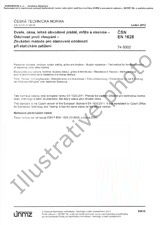We need your consent to use the individual data so that you can see information about your interests, among other things. Click "OK" to give your consent.
ČSN EN ISO 899-2 (640621)
Plastics - Determination of creep behaviour - Part 2: Flexural creep by three-point loading
Translate name
STANDARD published on 1.5.2025
The information about the standard:
Designation standards: ČSN EN ISO 899-2
Classification mark: 640621
Catalog number: 520996
Note: WITHDRAWN
Publication date standards: 1.5.2025
SKU: NS-1219608
The number of pages: 28
Approximate weight : 84 g (0.19 lbs)
Country: Czech technical standard
Category: Technical standards ČSN
Preview of the standard ČSN EN ISO 899-2 (640621)
We recommend:
Technical standards updating
Do you want to make sure you use only the valid technical standards?
We can offer you a solution which will provide you a monthly overview concerning the updating of standards which you use.
Would you like to know more? Look at this page.




 Cookies
Cookies
